A new song by SFW. When I first heard the demo it sailed straight and true into my heart. I just had to cover it. Thanks SFW for the gentle words and music.
[Cover art copyright Eva Vecino 2015]
A new song by SFW. When I first heard the demo it sailed straight and true into my heart. I just had to cover it. Thanks SFW for the gentle words and music.
[Cover art copyright Eva Vecino 2015]
September 2014
The iPod Classic is discontinued.
I was a late convert to owning music digitally. In 2007 I bought my first iPod and started the laborious task of burning all my CD collection onto the computer. Like the writer in this article says, your music collection, owned (and shared through your life) is a precious thing. From the days I borrowed friends LP records and recorded them onto my compact cassette of choice (the BASF Chrome [CrO2] Type II C90 cassette), having my bundle of cassettes – my collection – was always important to me. Those cassette storage boxes were bulky and even darn hazardous at times. Once I rolled a car half way down Mount Kaputar and the only injuries I sustained were from all the cassettes on the passenger seat next to me flying loose out of their cassette racks and slamming with their pointy plastic boxes edges into my head! Now my iPod purrs away in the glove box connected to my customised interface in the double DIN slots in my dash. And all twenty two thousand songs I’ve collected are there. My music IS collected. From the Celtic pipes of northern Spain while walking the Camino de Santiago (Berrogüetto) to the shoe-gaze cerebral fuzz of Chile’s Magellanic province (https://myspace.com/invernessilluminaciones), I’ve let my roaming ears enjoy and then encapsulate. Aural postcards to be forever reinvented in the contexts and conversations they provoke. And so the iPod is gone from Mr Job’s online store. Already the hawkers are selling them on eBay for twice the former RRP. For how much longer can I carry my own collection as defined by my travels on my own portable device? For how much longer will I resist the hire and rent proffered by the music landlords of the present future past. The iPod is dead. Long live the iPod.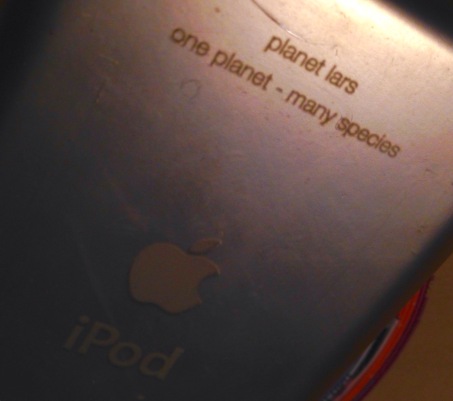
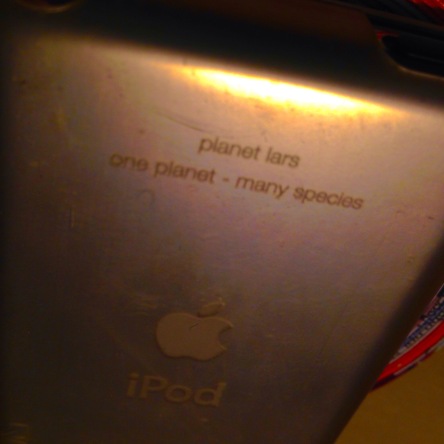
Paso Canoas
Costa Rican – Panama Border Crossing
Panamanian Immigration Control Point
18:05 hours local time
24th February 2014
Since I left Guatemala I’ve had one thing on my mind: the Darien Gap. After nearly two weeks of snaking through the pulsing delights of Central America’s chaotic capitals I still didn’t know how I was going to negotiate that last section, which would take me out of this funnelling isthmus into the South American continent.
There is no official road. The Pan American stops at Yaviza on the Chucunaque River in Panama; forty odd kilometres from the Colombian border. Travellers have died at the hands of irate ‘narcos’ while trying to trek through the jungles of this biodiversity hotspot. Or they simply got lost. So as I approached the Panama border, with all these questions swirling in my mind, I wasn’t anticipating my plans being thwarted so soon.
We spilled out of the icy confines of our San Jose bus into the thick humid night air. Buses of all sizes and shapes were embarking and disembarking their passengers. People stood beside road side food stalls. Some spoke on mobile phones hired from entrepreneurial kids by the minute. Others wiped their brows of sweat and grime. I lined up in the dimly lit border control area and started reading the mishmash of notices stuck to the window separating us from the Panamanian immigration officials. One caught my eye and sent fear and loathing throughout my sleep deprived body — Conditions of Entry: Proof of onward ticket to country of residence and possession of US$500. I had neither. The beaded sweat on my brow began to trickle.
He communicated with me in clipped monotonic Spanish and having heard my story the smartly dressed official looked at me tiredly and with disdain.
“Not good enough! Stand to one side,” he growled.
With his narrowing eyes he waved the next in line to come forward. I stood my ground, slightly embarrassed as I saw other backpackers happily displaying proof of their onward tickets and ample cash produced from inside their sodden money belts.
The sweat was now coursing down my spine.
I didn’t want to buy a ticket back to Australia that I wasn’t going to use. And I thought that my credit card would have sufficed. I was fixated on travelling overland to South America. And I was going to make this border official understand my single-mindedness. I asked again, pleaded with the guy. He stared past me and nonchalantly changed his demand to proof of purchase of air ticket from Panama to Colombia and promptly turned away. I was desperate. Contingency plans loomed large.
After an hour of border processing my bus was reloaded and the driver was hassling me. He had no obligation to wait.
I returned to the counter yet again and tried a different official. Same response. He told me to rush off and buy that ticket to Colombia. I insisted again that I would be travelling overland through Panama to Colombia and that there was no way of buying these sorts of trips in advance. I was running by the seat of my pants. I had no where else to go.
I turned to the bus driver.
“I gotta go fella. Sorry!”, he quipped shrugging his shoulders and raising his eyebrows.
I huddled with him in conference. I begged him to hold on. And I went back to the window.
The melee of passengers had died and the officials were engaged in light conversation inside their brightly lit office. I looked sideways at my fellow passengers looking out the bus windows at me with a mixture of bemusement and concern. My sweat soaked shirt clung to my back. I waved nervously to attract the attention of one of the officials. I explained my situation for the umpteenth time. All of a sudden he dropped the ticket demand entirely. Looking down he rubbed his forehead and in gruff tones demanded now to see the US$500 cash. I only had $140. He asked for a credit card. My eyes beamed with renewed confidence. I waved it like a lunatic in the air. But now he was demanding to see how much money I had in the bank.
I begged again for my driver to wait and I ran to the Internet cafe dodging trucks and motorbikes, dogs and puddles. In a panic I logged on. Asked the half asleep girl to print the screen dump. And with bank balance in hand rushed back to the border control.
He slowly reviewed the screen dump print out. Scratched it to see if it was real. And with elation swelling in my bones he signalled for me to stand before the camera, took my photo and stamped my passport. The driver was already taking the backpack off my shoulders.
Elated I boarded to a slow eruption of applause. With euphoria descending upon me I sat and reviewed the crumpled bank statement once again. My name appeared nowhere on it! Not to worry. The Darien Gap was once again within my sights.
In July 2012 I was in the awesome wilds of the wilderness-defining peninsula of Kamchatka. I saw a mere pin prick of this massive rim-of-fire landscape. And climbed the hardest thing I’ve ever climbed, the Avachinsky volcano (2750masl). And I must go back. While there I met Yale Professor, author and lecturer Fred Strebeigh http://www.strebeigh.com/ and learnt of his interest in the little known Russian wilderness preserves – zapovedniki – pre-dating all other nations’ attempts to do similar.
His insightful views and wonderful writings on the matter can be enjoyed here:
http://www.bbc.com/travel/feature/20140206-hiking-russias-geyser-valley/1
I’m sure I won’t fall into the same trap as last time. And when the El Salvadorean officials check my passport I hope they don’t recall what happened in May 2006!
Due to a damaged bridge on the border (over the dirty River Paz) only light traffic are crossing these days (and months!). So all passengers on our flash double deck bed-bus are merrily walking from this side (Valle Nuevo, Guatemala) to the other (Las Chinamas). It’s several hundred metres across a makeshift pedestrian extension hung out on one side of the bridge under repairs. Luckily they’re taking our checked on bags across in a ute for us.
Dodging the crazy money changers offering exchange of Quetzales to US Dollars (the Salvadorean currency for more than a decade now) I watch the ute (pick-up) with all the luggage go by in a swirl of dust; riding happily are three armed guards sitting variously on the luggage piled high. I spy my backpack poking out and smile.
Blessed are the money changers for they shall inherit the faulty calculators! They tried to rip me off and I came back to haunt them and claimed my dues.
Now I’m on the other side and in the other bus in the same top deck panorama seat and the Salvador immigration official is coming through the bus. He flicks through my passport and I’m wondering if he has access to my immigration fine from eight years before! I maintain my gaze straight ahead. He hands the passport back. No stamp!? He insists that no stamp is needed and he moves on from seat to seat registering each passengers passport details. Once bitten, twice shy! I insist on the stamp. With a weary sigh he repeats a third time for my benefit – and the bus’s – that an entry stamp is not necessary.
With a little twinge of doubt I sit back and watch the dry hot world of El Salvador flash past before me.
The first reported death from Dengue Fever in Paraguay for 2014 came on January 9th.
A few days ago I was laying in bed in the huge and airy house of Rose-Mary Wood and her husband Eduardo in the hot and leafy outer suburbs of Asuncion. The morning birds and mooing cows wandering the suburban parks was interrupted by the sound of fumigation pumps starting up. The government fumigating teams had arrived to ‘liberally dust’ the yards and corners of their house. Who knows what chemicals were wafting in the air. At the time though I didn’t know what the sound was all about and went back to sleep.
In 2013, Paraguay had one of the worst outbreaks of dengue fever in the history of the country: 154,287 cases of acute febrile syndrome, of which 131,314 were confirmed in the laboratory as being dengue fever and 248 deaths (70 in 2012) *.
* http://www.eldiario.es/politica/Primer-muerto-dengue-Paraguay-fallecidos_0_216279168.html
Back in the days when sailing ships sailed the old trade routes, Cape Horn was an infamous part of every sailor’s life. Many sailors reached rock-bottom in the harsh weather conditions that prevailed either side of the Drake Passage. Nonetheless sailing around Cape Horn was considered quite an achievement.
In 1933 a group of French sea captains that had all sailed Cape Horn established the Amicale des Capitaines au Long Cours Cap Horniers (AICH). Their aims remain the same today:
“To promote and strengthen the ties of comradeship which bind together in a unique body of men and women who embody the distinction of having sailed round Cape Horn in a commercial sailing vessel, and to keep alive in various ways memories of the stout ships that regularly sailed on voyages of exceptional difficulty and peril, and of the endurance, courage and skill of the sailors who manned them.”
The Dutch section of AICH welcomes new Cape Horn sailors and honours them with a token certificate of achievement. To be eligible for this certificate one must show perseverance and actively participate in the ship’s watch system for an extended period of time on a sailing ship rounding Cape Horn by sail from 50° South in the Pacific Ocean to 50° South in the Atlantic Ocean (or vice versa). The length of the voyage should be at least 3000 miles under sail alone.
Between October and December 2013 we achieved this minimum. Indeed we achieved a lot more, having sailed all the way from Australia to the Falkland Islands under sail alone. As such we became eligible to join this elusive and exclusive club of Cape Horn sailors.
A sailor that rounds the Horn is entitled to wear a gold loop earring. Tradition has it that this should be worn in the ear that faced the Horn as it was rounded. As such in the typical eastbound passage, like I’ve just completed, the earring should be worn in the left ear. As it happens I’ve already got two earrings in the left ear. Prescient of me one might say!
There are immense privileges to sailors who have rounded the horn. They include being allowed to dine with one foot on the table. If one has rounded the Cape of Good Hope as well then such a sailor would be permitted to put both feet on the table.
In terms of tattoos, one may obtain a tattoo of a fully rigged ship once a true rounding of Cape Horn has been achieved.
And finally, in order to be able to “spit into the wind” one would need to have made three true Cape Horn roundings (NB: I tried with just one rounding under my seaman’s belt; it failed dismally!).
One of the true Cape Horners was Captain James Cook, master of the Endeavour 1766-71 who sailed around the Horn in both directions. Not only could he spit into the wind, rumour has it that he could piss into the wind too!
Returning now to the certificate of achievement; there is one logistical issue to reckon with – one has to collect one’s certificate in the Dutch city of Hoorn in person.
My Cape Horn Certificate awaits my collection. And I can feel another adventure brewing.
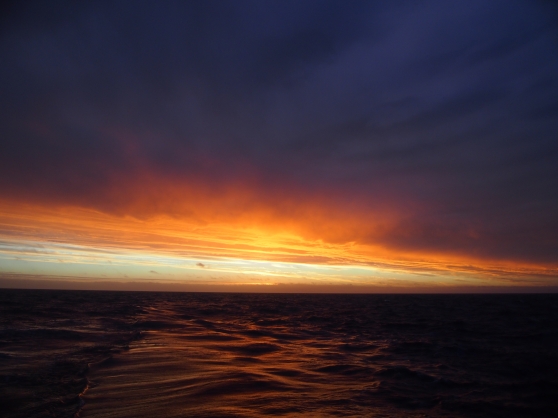
The last of the cool late summer southern sea evenings, Southwest Atlantic, between Falklands and the River Plate
The final leg of my 16,000 kilometre ocean voyage from Sydney, Australia to La Colonia, Uruguay started on 20th December 2013 in Stanley, Falkland Islands / Puerto Argentino, Las Malvinas. Behind me now was the completion of a ‘True Rounding of Cape Horn‘ (i.e. a minimum of 3000 nautical miles under sail from 50° South in the Pacific Ocean to 50° South in the Atlantic Ocean – see previous blog http://wp.me/p2EUa2-7Y) and the final leg had the singular distinction of a northerly trajectory in difference to months of easterly progress.
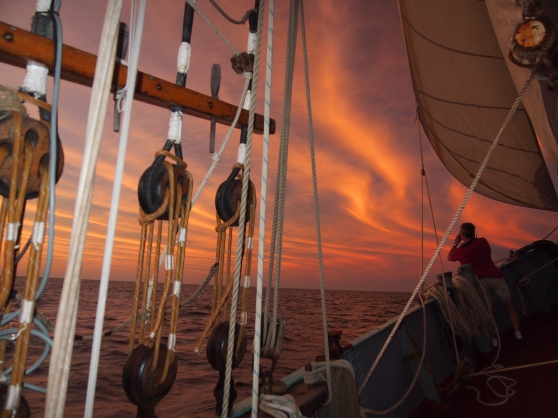
Northerly progress brings faster sunsets, Southwest Atlantic, between Falkland Islands and the River Plate
Starting off cold, windy and overcast we left that slice of British sovereignty and stubbornness, the Falkland Islands and its hundreds and thousands of windswept and sand-blasted penguins, seals, sea lions and breeding seabirds. We headed into increasing head winds; stiff northerlies. And we were forced to set the Iron Sail – the engine. We powered north into a big mist half way between the Falklands and the River Plate, our surrounding temperate airs being collided by the hot humid mass from the summer-soaked continent of South America to the north. We then started the slow process of peeling off the layers. The layers and layers that I’d come to consider part of my very self: woollen thermal underwears, long cotton mid-layers, extra mid-layers of cotton, followed by woollen jumpers and then the outer layers of wind-proof and water-proof fabrics.
Christmas Eve came and went while on watch on a steady calm ocean, still cool enough to keep most of one’s layers on while up on deck. And the colours in the evening sky were a perfect accompaniment to dream of the peace we all wish for at this time of the year. On Christmas Day we all gathered for a Christmas Dinner of the Crew and taking advantage of a moment on the high seas to let down our collective hair we all got a bit tipsy. Captain Gijs took control of the helm with his father Jan, allowing the rest of us a moment to cease our duties.
In the post-Christmas days that followed, warmer and warmer it became. Small whiffs of humid warmth, subtle in their appearances, would excite the skin on our hands and faces, cut short by the still lingering frigidness of our old friend the southern salty sea winds. A tern appeared and chased our mast, at last settling on our bowsprit and I was reminded of the messenger tern that fare-welled us when we left New Zealand at the end of October (see http://wp.me/p2EUa2-5B). I took it again as a good sign for Cape Horner like me.

A tern pauses on Tecla’s bowsprit to greet us as we approach the mouth of the River Plate, Argentine continental shelf, Southwest Atlantic Ocean
Then three days south of the River Plate the heat finally broke through the thermo-tone and suddenly we were all in shorts and dousing buckets of warm salty muddy ocean waters over our heads. The ocean colour had changed. Having passed over the Argentine Abyssal Plain (at an average 5000 metres depth) we’d sailed over that steep incline rising up onto the Argentine continental shelf (100-150 metres deep). Gone were the clear crisp deep blues of the Southern Seas. The turbid brown of the River Plate was upon us. And the sea and ambient air temperatures climbed and climbed. I burnt my feet under the sun on the deck. We considered sleeping on the deck at night, such was the heat below. And we started seeing the first land insects. And for the first time in months giant container ships sullied our horizon vistas and airplane contrails coursed the cumulonimbus clouds above us. This was somewhat of a shock to my gentle sea-pulsing person.
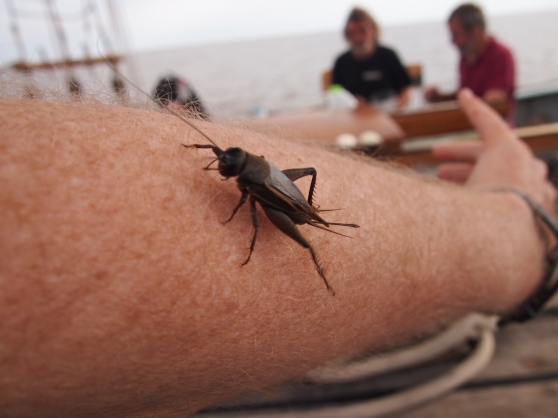
A cricket suddenly appears and the land is yet to come into sight, River Plate mouth between Uruguay and Argentina
A day before we entered the River Plate we were informed via radio that the Buenos Aires Port Authority wanted to charge us US$10,000 to enter. In mid-December the Captain had completed the necessary paper work with the Argentine authorities prior to arriving at the Falkland Islands / Las Malvinas. Problems arise for vessels leaving the Falklands wishing to enter Argentine continental ports. Without prior permission from the Argentine Government a vessel coming from the Falklands is considered to have entered Argentina illegally and without the prior approvals and consents. We had these, but another way to play international geo-politics is to simply charge exorbitant fees.
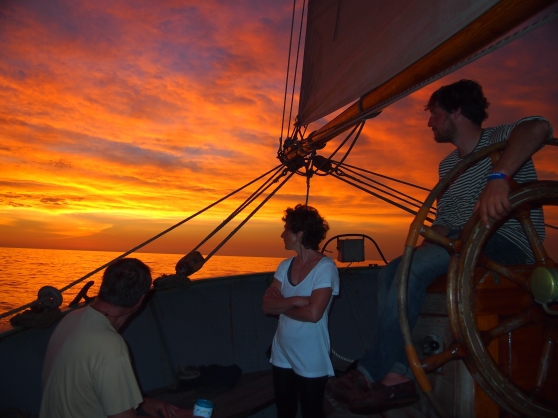
My Tecla sailing colleagues witness one of the last oceanic sunsets on this my final leg
Mouth of the River Plate, between Uruguay and Argentina
The Captain was not keen on paying these fees and so we changed tack and headed across the now shallower River Plate waters (10-15 metres deep) to Uruguay and the World Cultural Heritage-listed port of La Colonia del Sacramento (originally a 17th Century strategic Portuguese fort in the colonial days of the Continent). It was piercing hot (+40 degrees) and sweat-forcingly humid when we arrived. Neighbouring Buenos Aires was having power failures due to high summer loads on its failing electricity grid; chaos for them during this end-of-the-year festive season. Uruguay, relaxed and comfortable in itself, was coping much better. We anchored just offshore. It was Sunday and Uruguayans were variously swimming, fishing, zooming on jet skis or sitting under hundreds of umbrellas drinking beer. While Captain Gijs headed ashore alone to the small yacht club mariner in the zodiac with all our passports, we set about celebrating our arrival. An hour later Gijs climbed aboard with stamped-passports in hand. We were now officially in Uruguay. Jan, Tecla’s owner, clapped his hands and bowed down low and reverently to the big old ‘iron sail’ – still ticking and popping and hissing below in the bottom of the ship. This was one of the longest sustained uses of the motor in Tecla’s circumnavigation of the planet’s oceans. It had powered us most of the way from the Falklands and he was thankful for its flawless duty in transporting us from our southerly place of solace.
It was hard to believe my sea journey was at an end. The land now beckoned. And thinking of what the first ship-load of Australian utopian colonists did when they arrived on Uruguay’s exotic shores 120 years before I immediately fixated upon striking ashore and tasting some ice-cold beer.
But first priority was a dive into the fast flowing current of the River Plate. And then some aloe vera applied to toasted flesh.
11.01.2014, Estancia Zapallo, Amambay, Paraguay
These leaf-cutter ants are actually busy carting petals and flower parts from one of the nearby large forest trees (with bright red-flowers across the canopy). They are taking them down into their cavernous nest below ground where they are feeding their mother-lode of fungi. They create a stockpile of this organic material down below and the fungi does its job of breaking it down. The ants in turn feed on the fungal hyphae. Meanwhile, above on land the heat of the day rises on Estancia Zapallo and the task of fixing the wheel on the nearby old horse cart has stalled.
11.01.2014, Estancia Zapallo, Amambay, Paraguay
A real morning event I witnessed, while visiting the hot, green, dissected-plateaux of Amambay, Paraguay.
I awoke before 0600 hours and staggered into the rustic kitchen of the big estancia house, that was once owned by Paraguay’s ex-president Wasmosy (Paraguay’s first civilian president in 39 years). I was recovering from two days of diarrhea that I believed was started when I ate some sun-driend meat in the Chaco, south-west of Concepcion.
The first thing I saw in the creeping dawn light was this tarantula on the kitchen tiles. It was in silent consumptive mode, eating a small frog.
The frog remains alive, paralysed while the spider sucks out its life juices. Note for scale the Paraguayan box of matches (marca ‘Qué Luz’) behind during the end of the first take.